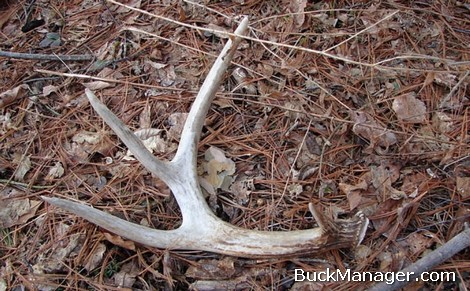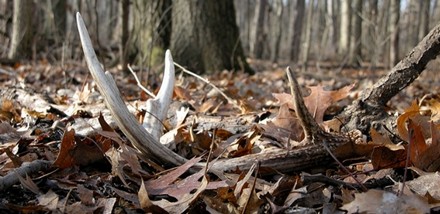Whitetail hunters look forward to fall each year because it signifies deer hunting season. Shed hunters, on the other hand, look forward to very late winter and early spring because that means it’s time to search for dropped antlers! Okay, not everyone is on board with shed hunting, but for those of use that enjoy getting back out into the woods between seasons it can be quite rewarding, as well as informative. It’s also good exercise and helps hunters learn more about the woods they hunt.
Finding shed antlers is always cool. A shed antler lets me know that at some point in the recent past the buck that lost the antler was standing, traveling or bedding right there. It may not seem like much, but years of finding shed antlers can allow a hunter to get some good data about where antlers are lost, or better stated, where bucks are hanging out. From a deer management perspective, it can give hunters and landowners an idea of buck habitat use after the rut and before spring green-up.

Received via email: “I plan to go hunting for antlers that have been shed for the first time this year. My neighbor, who is an avid deer hunter, told me that the best time to look for them here (Kansas City area) is during the first half of February. Is there anything I need to know before I venture out there? Are the antlers safe to pick up with bare hands? Do they need to be cleaned before taken into the house? Are they bloody after falling off? Do they have any odor? Is there any special area to look for them, or are they generally just kind of out in the open where they can be easily spotted? I am OBVIOUSLY a novice at this!”
Hunting for shed antlers should always be more fun than work, although it usually takes logging a few miles to cover some country. From my experience, the number of sheds you find will be directly proportional to the amount of country you cover. Walking and looking a lot means more antlers in your hands, but there are many other factors that affect the odds of finding sheds. Deer density and buck to doe ratio immediately come to mind. Obviously, searching in areas where there are deer is a must.
Sometimes, however, it’s easy to find shed antlers in areas where you don’t normally see deer, such as wide open fields or plots. Just because deer are not hanging out on a field during the day does not mean that they are never there. Fields with little cover or short grass can be covered quickly by stopping and scanning with a set of binoculars or covered thoroughly on a four-wheeler. Food plots also fall into this category when they offer good visibility.

Deer trails, drainages, fence lines, natural funnels and water sources are always good places to look for sheds. Whitetail often inhabit thick cover. They may hold some shed antlers, but brushy habitat can be difficult to search because they limit both mobility and visibility. I will get into such areas occasionally, but mostly stick to park-like stands of trees and the edges of woods. You see, like me, deer do not want to make life any harder than it has to be.
Deer antlers are quite clean because Mother Nature takes care of most of the washing post-drop. If you want to go “clean-freak” on them you can wash them with soap and water or a mild bleach mixture before carrying them in. I’ve found that some antlers will still have debris on them (around bases) from rubs, so I have rinsed these off in the past. Cleaning them could be a good idea if you have kids that will chew on them. Most people will not detect much, if any, odor on shed antlers, but dogs can be trained to help find sheds. Train your dog to find shed antlers and your tally will skyrocket.
In short, hunting for shed antlers is a lot of fun. Some days you will find more than others. To improve your odds, wait as long as you can, but before green-up, before going out to look. Some bucks drop early, others drop late. Waiting longer equates to more antlers on the ground, increasing the odds in your favor. Always head out antler hunting before things warm up too much and ground cover gets tall and thick. Limited visibility as well as the temperature will work against you. Best of luck!